| Article ID | Journal | Published Year | Pages | File Type |
|---|---|---|---|---|
| 2058566 | Meta Gene | 2016 | 8 Pages |
•The bonnethead shark mitogenome is quite similar in size to that of other Carcharhinidae species•Larger mitogenomes were observed for species from the most basal lineages•The ND2 gene showed the highest mean number of nucleotide differences at the inter-generic level within Carcharhiniformes•The Bayesian analysis of 49 Elasmobranch mitogenomes supported the view that sharks and batoids are separate groups
Elasmobranchs are one of the most diverse groups in the marine realm represented by 18 orders, 55 families and about 1200 species reported, but also one of the most vulnerable to exploitation and to climate change. Phylogenetic relationships among main orders have been controversial since the emergence of the Hypnosqualean hypothesis by Shirai (1992) that considered batoids as a sister group of sharks. The use of the complete mitochondrial DNA (mtDNA) may shed light to further validate this hypothesis by increasing the number of informative characters. We report the mtDNA genome of the bonnethead shark Sphyrna tiburo, and compare it with mitogenomes of other 48 species to assess phylogenetic relationships. The mtDNA genome of S. tiburo, is quite similar in size to that of congeneric species but also similar to the reported mtDNA genome of other Carcharhinidae species. Like most vertebrate mitochondrial genomes, it contained 13 protein coding genes, two rRNA genes and 22 tRNA genes and the control region of 1086 bp (D-loop). The Bayesian analysis of the 49 mitogenomes supported the view that sharks and batoids are separate groups.
